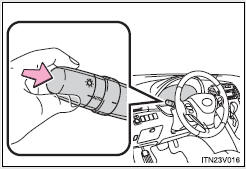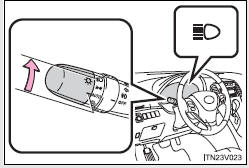Toyota Venza: Automatic High Beam
The Automatic High Beam uses an in-vehicle camera sensor to assess the brightness of streetlights, the lights of oncoming and preceding vehicles, etc., and automatically turns high beam on or off as necessary.
- Activating the Automatic High Beam system

Push the lever away from you with the headlight switch in
 position when the “ENGINE START STOP”
position when the “ENGINE START STOP”
switch is in IGNITION ON mode (vehicles with smart key system) or the engine switch
is in the “ON” position (vehicles without smart key system).
The Automatic High Beam indicator will come on when the headlights are turned on automatically to indicate that the system is active.
- Turning the high beam on/off manually
► Switching to low beam

Pull the lever to original position.
► Switching to high beam

Turn the light switch to  position.
position.
- High beam automatic turning on or off conditions
When all of the following conditions are fulfilled, high beam will be automatically turned on (after approximately 1 second):
• Vehicle speed is above approximately 20 mph (32 km/h).
• The area ahead of the vehicle is dark.
• There are no oncoming or preceding vehicles with headlights or tail lights turned on.
If any of the following conditions are fulfilled, high beam will be automatically turned off:
• Vehicle speed drops below approximately 20 mph (32 km/h).
• The area ahead of the vehicle is not dark.
• Oncoming or preceding vehicles have headlights or tail lights turned on.
- Limitations of the Automatic High Beam
Do not rely on the Automatic High Beam. Always drive safely, taking care to observe your surroundings and turning high beam on or off manually if necessary.
- Camera sensor detection information
• High beam may not be automatically turned off in the following situations:
• When oncoming vehicles suddenly appear from a curve.
• When the vehicle is cut in front of by another.
• High beam may be turned off if an oncoming vehicle that is using fog lights without using the headlights is detected.
• Houselights, streetlights, red traffic signals, and illuminated billboards or signs may cause the high beam to turn off.
• The following factors may affect the amount of time taken to turn high beam on or off:
• The brightness of headlights, fog lights, and tail lights of oncoming
and preceding vehicles
• Road conditions (wetness, ice, snow etc.)
• The number of passengers and amount of baggage
• High beam may be turned on or off when unexpected by the driver.
• In the situations below, the system may not be able to correctly detect the surrounding brightness levels, and may flash or expose nearby pedestrians to the high beam. Therefore, you should consider turning the high beam on or off manually rather than relying on the Automatic High Beam system.
• In bad weather (rain, snow, fog, sandstorms etc.) • The windshield is obscured by fog, mist, ice, dirt etc.
• The windshield is cracked or damaged.
• The inside rear view mirror or camera sensor is deformed or dirty.
• Surrounding brightness levels are equal to those of headlights, tail lights or fog lights.
• Vehicles ahead have headlights that are either switched off, dirty, are changing color, or are not aimed properly.
• When driving through an area of intermittently changing brightness and darkness • When frequently and repeatedly driving ascending/descending roads, or roads with rough, bumpy or uneven surfaces (such as stone-paved roads, gravel tracks etc.) • When frequently and repeatedly taking curves or driving on a winding road • There is a highly reflective object ahead of the vehicle, such as a sign or a mirror.
• The vehicle’s headlights are damaged or dirty.
• The vehicle is listing or tilting, due to a flat tire, a trailer being towed etc.
• The Automatic High Beam indicator is flashing.
• The high beam and low beam are repeatedly being switched between in an abnormal manner.
• The driver believes that the high beam may be causing problems or distress to other drivers or pedestrians nearby.
- If the Automatic High Beam indicator flashes..
.
It may indicate a malfunction in the system. Contact your Toyota dealer.
- Customization
The Automatic High Beam can be turned off.
(Customizable features )
- Temporary lowering sensor sensitivity
The sensitivity of the sensor can be temporarily lowered.
To lower the sensitivity, push and hold the “AUTO” button on the inside rear view mirror for 15 to 20 seconds, and release. The indicator light on the inside rear view mirror will flash to indicate that the sensitivity has been lowered.
Vehicles with smart key system:
When the “ENGINE START STOP” switch is turned off, the sensitivity will be returned to its normal level.
Vehicles without smart key system:
When the engine switch is turned to the “LOCK” position, the sensitivity will be returned to its normal level.
NOTICE
- Camera sensor

Observe the following to ensure that the Automatic High Beam functions correctly.
• Do not touch the camera sensor.
• Do not subject the inside rear view mirror or the camera sensor to a strong impact.
• Do not disassemble the camera sensor.
• Do not spill liquid onto the inside rear view mirror or the camera sensor.
• Do not apply window tinting or stickers to the camera sensor or the area of windshield near the camera sensor.
• Do not place items on the dashboard. There is a possibility that the camera sensor will mistake items reflected in the windshield for streetlights, the headlights of other vehicles, etc.
• Do not install a parking tag or any other accessories near or around the inside rear view mirror and the camera sensor.
• Do not overload the vehicle.
• Do not modify the vehicle.
• Do not replace windshield with a non-genuine windshield.
Contact your Toyota dealer.
 Headlight switch
Headlight switch
The headlights can be operated manually or automatically.
Turning the end of the lever turns on the lights as follows.
Type A
The daytime running lights turn
on.
The headlights, parking lig ...
 Fog light switch
Fog light switch
The fog lights improve visibility in difficult driving conditions, such as
in rain or fog. The fog lights can be used when the headlights are on low beam.
Type A
1. Off
2. On
Type B
1. O ...
Other materials about Toyota Venza:
Dtc Check / Clear
DTC CHECK / CLEAR
1. CHECK DTC
(a) Connect the Techstream to the DLC3.
(b) Turn the engine switch on (IG).
(c) Turn the clearance sonar main switch on.
(d) Turn the Techstream on.
(e) Enter the following menus: Body Electrical / Intuitive P/A / DTC.
(f) ...
Data Signal Circuit between Navigation Receiver Assembly and Extension Module
DESCRIPTION
The stereo component tuner assembly sends the image data signal to the navigation
receiver assembly via this circuit.
WIRING DIAGRAM
PROCEDURE
1.
CHECK NAVIGATION WIRE
(a) Remove the navigation wire (See pag ...
Outer Rear View Mirror Glass
Components
COMPONENTS
ILLUSTRATION
Inspection
INSPECTION
PROCEDURE
1. INSPECT OUTER MIRROR RH
(a) Check the outer mirror heater operation.
(1) Measure the resistance according to the value(s) in the table below.
Standard Resistanc ...
0.1326
